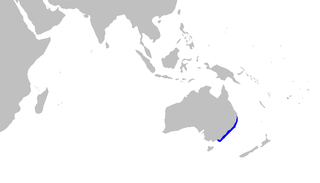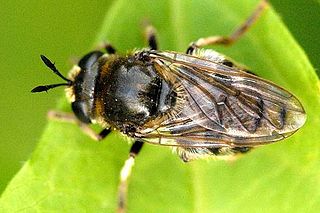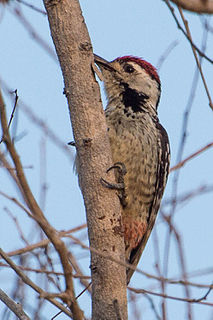
True thrushes are medium-sized mostly insectivorous or omnivorous birds in the genus Turdus of the wider thrush family, Turdidae. The genus name Turdus is Latin for "thrush". The term "thrush" is used for many other birds of the family Turdidae as well as for a number of species belonging to several other families.

The black-faced antthrush, is a species of passerine bird in the family Formicariidae.

The intergluteal cleft or just gluteal cleft, also known by a number of synonyms, including natal cleft, butt crack, and cluneal cleft, is the groove between the buttocks that runs from just below the sacrum to the perineum, so named because it forms the visible border between the external rounded protrusions of the gluteus maximus muscles. Other names are the anal cleft, crena analis, crena interglutealis, and rima ani. Colloquially the intergluteal cleft is known as bum crack (UK) or butt crack (US). The intergluteal cleft is located superior to the anus.

The Australian spotted catshark is a catshark of the family Scyliorhinidae, found only around Australia between 32 and 38°S, at depths between 10 and 180 m. It can grow up to 90 cm. Females of this species were observed as being reproductive year round. They are also confirmed as being a single oviparous species.

The Attelabidae is a widespread family of weevils. They are among the primitive weevils, because of their straight antennae, which are inserted near the base of the rostrum. The prothorax is much narrower than the base of the elytra on the abdomen. Attelabidae and the related family Rhynchitidae are known commonly as the leaf-rolling weevils. Rhynchitidae may be treated as subfamily Rhynchitinae of the Attelabidae.

Microdon analis, is a species of hoverfly. It is found in the Palearctic. The distinctive almost slug-like larvae live in ants nests. The larvae are hemispherical in shape and heavily armoured. They are believed to prey on the eggs and larvae of a number of different ant species, notably Lasius niger and the Formica rufa group. These ants are usually found on heathland. However Schmid (2004) claims that Microdon analis and M. major which are cryptic species have been confused under the name analis. M.major is apparently associated with ants of the genus Formica, the other species, M.analis, with Lasius species.

Aithorape is a genus of moths in the family Megalopygidae.

The freckle-breasted woodpecker is a species of bird in the family Picidae. It is found in Indonesia, Laos, Myanmar, Thailand, Cambodia, and Vietnam.

Analı kızlı soup is a soup from South and Southeastern Turkey which includes meatballs, tomato, bulgur, and chickpeas. 'Analı kızlı' means, literally, 'with daughters and mothers', daughters being the chickpeas, and mothers the bulgur balls, all in a soup like a yogurt sauce. Another name for this dish is yuvalama or yuvarlama. It is a part of traditional Turkish cuisine.

Meatball soup is a soup made using meatballs, simmered with various other ingredients. The classic meatball soup consists of a clear broth, often with pieces of or whole meatballs with vegetables; common additions are pasta, dumplings, or grains such as rice and barley. Various types of meat are used, such as beef, lamb, pork and poultry.
Pseudosphex analis is a moth of the subfamily Arctiinae. It was described by Max Gaede in 1926. It is found in Bolivia.

Megaponera analis is the sole species of the genus Megaponera. They are a strictly termite-eating (termitophagous) ponerine ant species widely distributed in Sub-Saharan Africa and most commonly known for their column-like raiding formation when attacking termite feeding sites. Their sophisticated raiding behaviour gave them the common name Matabele ant after the Matabele tribe, fierce warriors who overwhelmed various other tribes during the 1800s. With some individuals reaching up to 25 millimetres (0.98 in) in length, M. analis is one of the world's largest ants.
Inga analis is a moth in the family Oecophoridae. It was described by August Busck in 1914. It is found in Panama.
Aithorape albicostata is a moth of the family Megalopygidae. It was described by Walter Hopp in 1927. It is found in Trinidad, Brazil and Paraguay.
Aithorape candelabraria is a moth of the family Megalopygidae. It was described by Walter Hopp in 1927. It is found in Peru.
Aithorape longanella is a moth of the family Megalopygidae. It was described by Walter Hopp in 1927. It is found in Peru.
Aithorape spinulata is a moth of the family Megalopygidae. It was described by Walter Hopp in 1927. It is found in Peru.
Aithorape flammicornis is a moth of the Megalopygidae family. It was described by Schaus in 1905. It is found in Brazil, Trinidad, Guyana, French Guiana and Venezuela.
Aithorape frontalis is a moth of the Megalopygidae family. It was described by Schaus in 1920. It is found in Guatemala.

Aithorape roseicornis, Dognin's satin, is a moth of the Megalopygidae family. It was described by Paul Dognin in 1899. It is found in Colombia, Ecuador and Peru, where it inhabits rainforests and cloudforests at altitudes between 200 and 1,200 meters.










